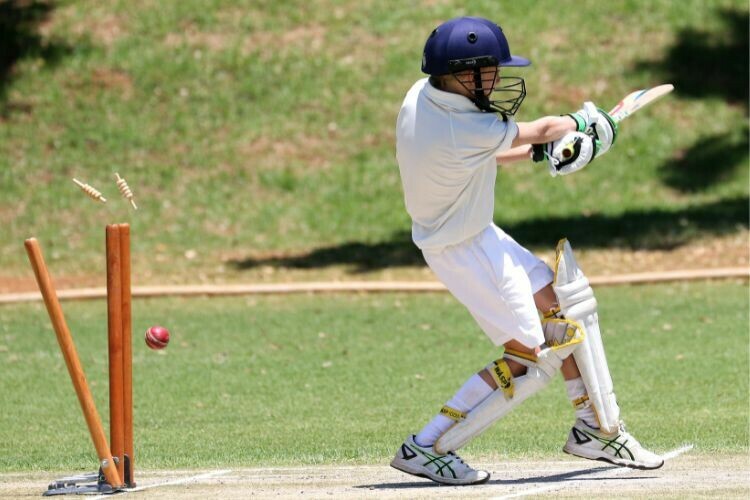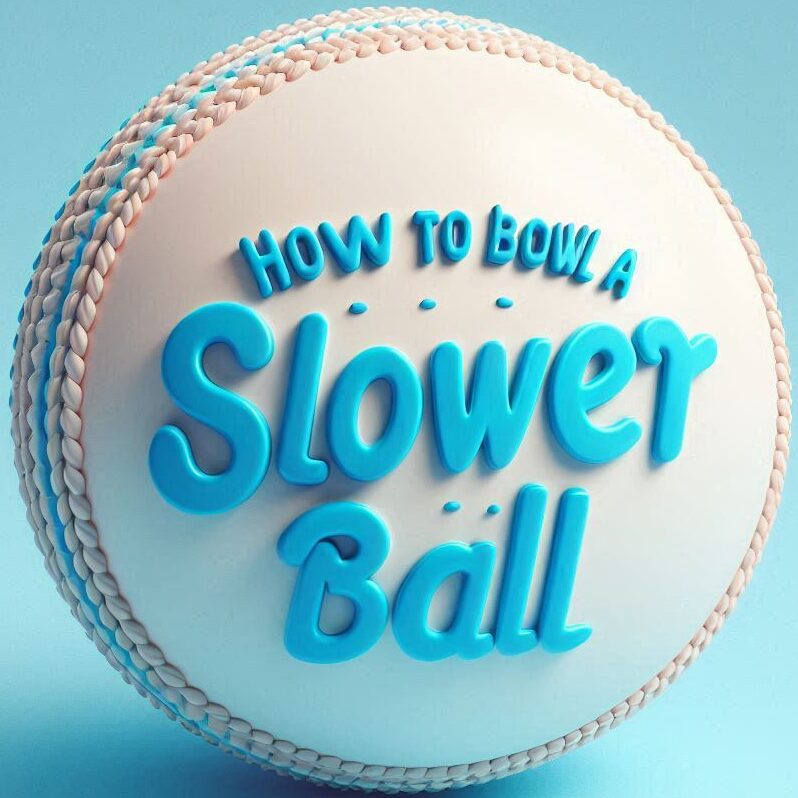In previous blog posts, we’ve talked about how to bowl inswing, outswing and how to bowl reverse swing. These are just three ways that you as a bowler can cause second-thoughts in the batter’s mind.
Today, we’ll talk about another way: bowling the slower ball.
And we don’t mean just running up and bowling the bowl slower than other deliveries. We mean, bowling the ball in such a way that the batter doesn’t realise the delivery is a slower ball until they are already half way through the shot.
We are talking about the deceptive art of how to bowl a slower ball without advertising it through a change of arm speed.
With the advent of one day cricket and T20 cricket in particular, it has become almost a requirement for a fast bowler to have a slower ball that the batter can’t pick. And not just one type of slower ball, but numerous types.
A slower ball’s effectiveness hinges on the element of surprise, making it a potent weapon against even the most aggressive batter.
Understanding the nuanced application of the slower ball is essential if you are looking to elevate your game and keep the batter guessing.
Slower Ball Introduction
A slower ball is primarily designed to disrupt the batsman’s timing. Typically delivered with an action similar to a regular delivery, its reduced speed, achieved through various grip and wrist techniques, causes the batter to play the shot early, leading to a possible catch or a miss.

As we’ve said, this ball is not just about reducing pace; it’s about cleverly disguising that reduction to make the delivery as natural-looking as possible. The key to its success lies in your ability to maintain a consistent action with your normal delivery, thus masking any intent to bowl slower.
In cricket, the duel between you, as the bowler, and the batter is as psychological as it is physical. The slower ball’s surprise factor elevates this contest to a tactical battle.
It introduces uncertainty—batters must be perpetually prepared for a change in pace, which can disrupt their rhythm and focus. When executed well, the slower ball can turn the tide of an innings, making it a crucial strategic tool during crucial overs, especially in the death overs where batters are looking to maximize scoring.
Incorporating the slower ball effectively requires you to have a well-rounded skill set. It should be used judiciously—overuse can make it predictable, while sparse use may keep batters constantly on edge.
Balancing when and how often to bowl slower deliveries is critical; it should complement your faster deliveries, bouncers, and swing or seam variations, thereby enriching their overall impact in the game. This balance helps maintain a psychological edge over batters, making the slower ball not just a trick up the sleeve, but a fundamental aspect of a nuanced bowling strategy.
Fundamentals of Bowling a Slower Ball
The effectiveness of a slower ball largely depends your ability to mimic your arm speed of your regular deliveries. This deception is crucial as it prevents the batter from picking up cues about the change in pace until it’s too late.
To achieve this, you must focus on keeping your arm rotation consistent, regardless of the ball’s actual speed. This requires significant practice to develop muscle memory, allowing you to deliver a slower ball with the same effort as a fast one, but with controlled release points or changes of wrist orientation that reduce the ball’s speed.
Another key aspect of delivering an effective slower ball is maintaining consistency in your action and follow-through, not just arm speed. Any deviation from the norm can alert the batsman to a change, diminishing the element of surprise.
You should practice your slower ball delivery in tandem with your regular bowling action, ensuring that your run-up, leap, and follow-through look identical regardless of the delivery. This consistency helps mask any intent, keeping the batter guessing and reacting instinctively, often to their detriment.
Types of Slower Balls
A bowler’s repertoire often includes a variety of slower balls, each with unique mechanics and strategic purposes. Understanding the nuances of different types of slower balls can significantly enhance your effectiveness as a bowler, allowing you to confuse and challenge batters across different formats and situations.
The Off-cutter and Leg-cutter
The off-cutter and leg-cutter are two of the most common types of slower balls, primarily differentiated by the direction of spin they impart on the ball.
The off-cutter, aimed to spin from off to leg for a right-handed batsman, is bowled by gripping the ball with the index finger closer to the seam and slicing across the ball at the point of release.
Conversely, the leg-cutter, which spins from leg to off, involves a grip where the middle finger is closer to the seam, with a slicing motion away from a right-handed batsman. Both deliveries deceive the batters with their spin and subtle change in pace, deviating from the expected trajectory after pitching.
The Back-of-the-hand Slower Ball
The back-of-the-hand slower ball is one of the most deceptive slower balls, delivered with the back of the hand facing towards the batter at the point of release.
This type of delivery is effective because it significantly reduces the ball’s pace while maintaining a normal arm speed. It requires you to rotate the wrist drastically, making it difficult for batters to pick up the visual cues until the ball is released.
This ball is especially useful in limited-overs cricket, where variations in speed can disrupt a batter’s aggressive rhythm.
The Split-finger Slower Ball
Originating from baseball, the split-finger is a potent slower delivery adapted by fast bowlers to add an unexpected dip to their arsenal. The ball is gripped with the index and middle fingers split wide on either side of the seam.
This grip causes the ball to leave the hand with less spin and reduced speed, leading to a sudden drop in trajectory as it approaches the batter.
The split-finger fastball is particularly effective against batters who charge down the wicket or those looking to hit over the top, as the sudden dip can lead to a mistimed shot.
Mastering the Disguise of Slower Deliveries
One of the primary challenges in bowling an effective slower ball is masking any visual or kinetic indicators that could alert the batter. Key tell-tale signs include a noticeable change in arm speed, altered run-up, or visible grip adjustments.
To avoid these, you should focus on maintaining a consistent run-up and arm speed across all your different types of deliveries. This consistency ensures that the action preceding the delivery offers no clue about the ball’s reduced pace, making it difficult for the batter to anticipate and react accordingly.
To further complicate the batter’s task, you can employ a range of strategic variations in your slower deliveries. This could mean altering the point of release slightly or using different types of slower balls (such as off-cutters, leg-cutters, and the split-finger) in unpredictable sequences.
By mixing these deliveries within regular overs, you can sow doubt in the batter’s mind about the pace and variation of the next ball, thereby disrupting their timing and shot selection.
The grip is often where a slower ball is made or broken. Subtle grip changes are crucial, as they allow you to reduce the ball’s speed without alerting the batter.
These changes should be minimal and executed within the natural movements of adjusting the ball in hand, making them nearly imperceptible to the batter.
Practicing these slight modifications in the grip, such as gently splitting the fingers or deepening the ball in your hand, can significantly enhance the effectiveness of the slower delivery.
Training and Strategy for Slower Ball Excellence
Targeted drills that focus on maintaining a consistent action while changing the pace are crucial. One effective drill is to practice bowling at a single stump with variations in speed but identical run-up and arm action.
This helps you develop muscle memory and control over the ball irrespective of its speed.
Another useful exercise involves using video analysis to monitor and adjust the subtleties in delivery that might telegraph your intent to bowl a slower ball. Regular feedback from coaches during these sessions can accelerate your improvement, making the variations seamless and more natural.
Understanding the tactical deployment of slower balls in different match scenarios is also vital. Slower balls are particularly effective during the death overs in limited-overs matches when batters are aggressively looking for quick runs.
Strategically, a slower ball can be used as a surprise element to dismiss set batters or disrupt the rhythm of the batting side. Planning these deliveries, based on the batter’s weaknesses and prevailing match conditions, can enhance your impact during critical phases of the game.
Studying successful implementations of slower deliveries by legendary bowlers offers valuable lessons. Watching T20 games and focusing on the different variations the bowlers use to try and either get the batsman out, or at the very least, curtail their scoring, can help you perfect the skill.
These case studies not only inspire but also provide practical examples of how subtle variations in pace and spin have outfoxed batters across different eras of cricket.
The Last Word On Bowling Deceptive Slower Balls
Becoming great at bowling slower balls requires dedication and a nuanced understanding of cricket mechanics. Maintaining consistency in action while varying pace demands rigorous practice and attention to detail.
Focus on perfecting your grip, delivery action and follow-through to ensure that each slower ball is as deceptive as possible.
Utilizing video analysis, targeted drills, and feedback from coaching staff are essential in honing this skill.
Moreover, understanding the tactical aspects of when to employ slower balls during matches can turn a good bowler into a great one.
I hope you have enjoyed this post on how to bowl a slower ball. Who is your favourite exponent of the slower ball? Either of the current age or the decades past? Leave your answers in the comment section below.

